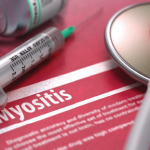Dr. Aggarwal advises, “It’s very important physicians screen for interstitial lung disease in these patients, because 70–80% may have or develop interstitial lung disease, and they need to be managed early.”
Anti-Mi-2 Autoantibody
First described in 1976, the anti-Mi-2 autoantibody became the first serological marker closely linked to DM, occurring in 10 to 30% of DM patients. Researchers later learned that this antibody is directed against the chromatin-remodeling complex, Mi-2/NuRD.1
These patients tend to have classic skin eruptions alongside mild to moderate myositis and less systemic disease. “Patients with anti-Mi-2 autoantibodies have a milder phenotype, which means these patients in most cases get better more easily and much faster,” explains Dr. Aggarwal. “Generally, you [don’t] need big guns, in the form of second- or third-line immunosuppression, for these patients. A little steroid taper with or without methotrexate or azathioprine may get them significantly better.”
Anti-MDA5 (CADM-140)
For patients with significant skin disease and lung disease, but little weakness, Dr. Gunawardena suggests an anti-MDA5 test. This autoantibody targets MDA5, a cytoplasmic sensor that triggers antiviral responses. It may be particularly prevalent in patients of Asian descent.2,3

Dr. Aggarwal
“These patients have generally poor prognosis, especially if they have interstitial lung disease—seen in half of the cases in the U.S.,” explains Dr. Aggarwal. “Their interstitial lung disease can be of a rapidly progressing nature, so a physician needs to act fast when they recognize a patient with interstitial lung disease and anti-MDA5 antibody. Otherwise, 50% of these patients with interstitial lung disease may die within three to six months,” he continues. “In patients with these antibodies, the skin rash tends to be more severe and the outcomes poorer if it’s not treated aggressively.”
In addition to providing information about initial prognosis, some autoantibodies may be able to play a role in monitoring disease activity. For example, high levels of anti-MDA5 despite treatment are a sign of refractory lung disease and increased mortality risk.9
The Boards of EULAR & the ACR recently approved this new set of classification criteria for idiopathic inflammatory myopathies. … The new myositis classification guidelines include various clinical characteristics, muscle biopsy findings & autoantibody results. … Having myositis autoantibodies gives half the points needed to achieve diagnosis of IIM under the new classification criteria.
Anti-TIF1-γ (p155/140) Autoantibodies
The autoantibody anti-TIF1-γ is a particularly important one to consider when assessing risk for cancer-related myositis, which is more common in patients with DM than PM. Patients with these autoantibodies often have significant disease-resistant skin disease. The autoantibody targets proteins in the human transcription intermediary factor 1 (TIF1) family.2,3

